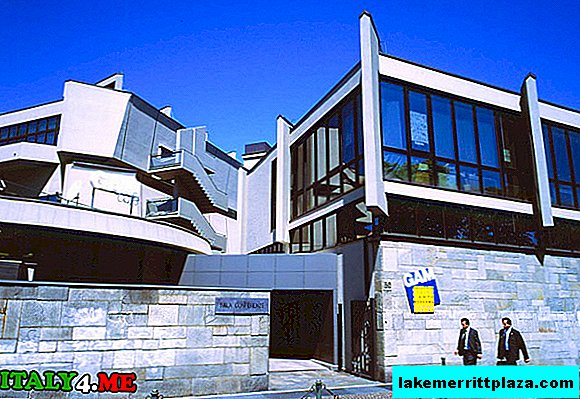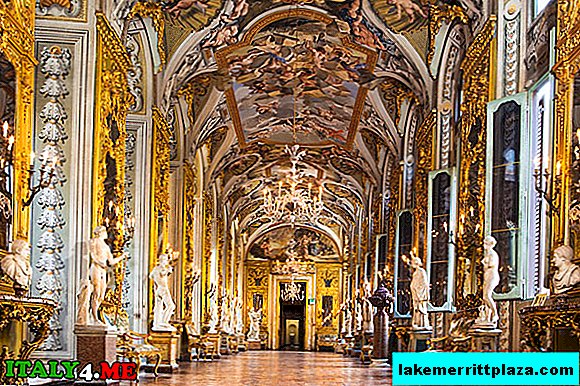Throughout its long history, Italy tirelessly gave the world talented artists whose names are not forgotten to this day. Some of the creations of the great masters are in the Sistine Chapel in the Vatican. However, Venice, Milan and Florence also have something to brag about. We have prepared ten of the most famous and amazing art galleries.
Gallery of Modern Art in Milan

Unfortunately, the area of the building of the gallery of modern art (Galleria d'Arte Moderna) is small in size, which is necessary to accommodate a huge number of works of famous artists, so many exhibits gradually "migrate" to other museums. This gallery is interesting for those who admire the art of 18-21 centuries.
- Official site: www.gam-milano.com
- Find a hotel in the center of Milan
- Sights of Milan
National Gallery of Modern Art in Rome

The origins of Roman modern art go back to the times when artists such as Boldini, Segantini and Fattori created. The National Gallery of Modern Art (Galleria Nazionale d'Arte Moderna e Contemporanea) was founded back in 1883.
- Official site: www.gnam.beniculturali.it
- Find a hotel in the center of Rome
- Sights of Rome
Civic Gallery of Art Nouveau and Contemporary Art in Turin

The first ever Civil Gallery of Art Nouveau and Contemporary Art (Galleria Civica d'Arte Moderna e Contemporanea) in Turin is dedicated to contemporary art. All those who worship Italian art of the 18th century can find here an impressive collection of Art Nouveau. Its highlight is the stunning scenery of Antonio Fontanesi.
- Official website: www.gamtorino.it
- Find a hotel in the historical center of Turin
- Turin Attractions
Corsini Gallery in Rome

The building of the Corsini Gallery (Galleria Corsini) was built back in the 15th century and underwent significant reconstruction in the 18th century. Despite its small size, the Corsini Gallery holds masterpieces of art of such art geniuses as Caravaggio, Brueghel, Poussin, as well as a whole collection of lesser-known Italian artists of the 17-18 centuries.
- Official gallery website: www.galleriacorsini.beniculturali.it
Colonna Gallery in Rome

The construction of the Galleria Colonna Gallery, the first brick of which was laid out in 1654, took half a century. Nevertheless, this massive complex fully reflects all the power and nobility of the Colonna clan, in whose honor it was created. Today, the Colonna Gallery is an amazing repository of world masterpieces of fine art and sculpture.
- Official site: www.galleriacolonna.it
Academy Gallery in Venice

The huge collection of the Venetian gallery of the Academy (Galleria dell'Accademia) contains more than five centuries. None other than Napoleon Bonaparte gave a personal order to transfer many masterpieces here. One of the most famous jewelry here can be called Paolo Veronese’s creation “Feast in the House of Levi” (Paolo Veronese “Cena a Casa di Levi”).
- Official website: www.gallerieaccademia.org
- Find a hotel in the center of Venice
- Sights of Venice
Pinacoteca Brera in Milan

The building of the Pinacoteca Brera (Pinacoteca di Brera) dates back to the 17th century, being part of the amazing architecture of the city. Here, styles such as the Italian Renaissance and Baroque were reflected. The Brera Pinacotheca collection includes representatives of art from both the modern period and previous centuries.
- Official Pinakothek website: www.brera.beniculturali.it
- Find a hotel near the Pinacoteca Brera
Gallery of the Academy of Fine Arts in Florence

The gallery was erected in 1784 as a place where the young talents of the Academy of Fine Arts (Accademia di belle arti di Firenze) could hone their artistic skills. Today the gallery of the Academy in Florence is the home of one of the most famous sculptures in the world - David the great Michelangelo.
- Recommended: find a hotel in the historical center of Florence and read about the best 4 star hotels
Uffizi Gallery in Florence

This amazing gallery (Galleria degli Uffizi) appeared between 1560 and 1580. Passionate connoisseurs of paintings of the Italian Renaissance can find here the best collection of masterpieces of this time in the Uffizi. Here are also collected works of Dutch, German and Spanish artists. The Uffizi houses the Medici personal collection.
- Uffizi Gallery official website: uffizi.firenze.it
- Find a hotel near the Uffizi Gallery
Vatican

The Vatican is a real repository of the works of artists and sculptors in Italy and not only. In addition to the museum of Roman and Greek antiquity, there is also the Sistine Chapel and other places of the accumulation of beauty.
- Official site of the Vatican Museums: mv.vatican.va
- Excursion to the Vatican Museums
- Find a hotel near the Vatican
- View photos from the dome of St. Peter's Basilica








